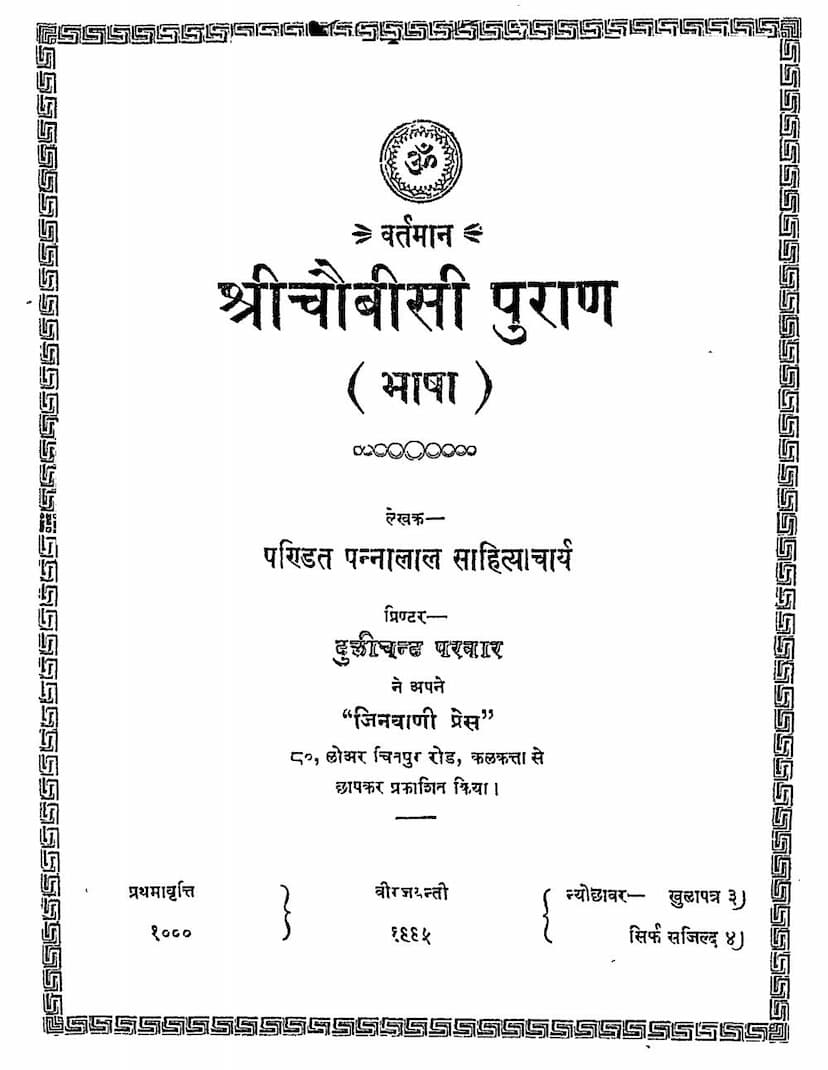Chobisi Puran
Added to library: September 1, 2025

Summary
This is a comprehensive summary of the "Chobisi Puran" by Pannalal Jain, published by Dulichand Parivar, based on the provided text:
Title: Chobisi Puran (Language: Hindi) Author: Pandit Pannalal Sahityacharya Publisher: Dulichand Parivar (Printed at Jinwani Press) Catalog Link: https://jainqq.org/explore/010703/1
Overall Description: The "Chobisi Puran" is a biographical account of the 24 Tirthankaras of Jainism. The book aims to provide detailed life stories of these revered spiritual leaders in a simple and accessible Hindi language. The publisher highlights the lack of such comprehensive life histories of all 24 Tirthankaras together in Hindi literature and expresses gratitude to Pandit Pannalal for his diligent work in fulfilling this need.
Content Overview:
The book systematically presents the life narratives of each of the 24 Tirthankaras. While the summary doesn't delve into the specifics of every Tirthankara's life, it provides a general outline of the structure and typical details found in such texts, as suggested by the initial pages:
- Introduction to Jain Cosmology: The initial pages (Pages 5-8) set the stage by describing the Jain cosmology, including the Jambu Dwipa, Meru Parvat, and the regions within it. This establishes the geographical and cosmological context for the lives of the Tirthankaras.
- Biographical Narratives: The core of the book consists of detailed accounts of the lives of the Tirthankaras. These accounts typically include:
- Previous Lives (Pūrvabhav): The text often traces the lives of the Tirthankaras in previous births, explaining the karmic actions and resolutions that led to their birth as Tirthankaras. This section provides insights into Jain philosophy regarding karma and reincarnation. The detailed summaries of the early Tirthankaras (Adhinath, Ajitnath, Sambhavnath) and Mahavir highlight this aspect.
- Birth and Childhood: The auspicious circumstances surrounding their birth, the divine signs that appeared, their names, and their childhood activities and intellectual development are described.
- Youth and Renunciation: The narratives often cover their marriages (if any), their eventual dispassion towards worldly pleasures, and their decision to renounce the world for spiritual pursuits.
- Spiritual Journey and Enlightenment: The text details their penance, spiritual practices, attainment of Kevala Jnana (omniscience), and the subsequent establishment of the fourfold Jain community (monks, nuns, laymen, laywomen).
- Teachings and Ministry: The sermons and teachings imparted by the Tirthankaras to guide humanity are a significant part of the narrative.
- Nirvana (Moksha): The final liberation and ascent of the Tirthankara to the highest spiritual realm are described.
- Symbolism: The book likely mentions the distinct symbols associated with each Tirthankara, which aid in their identification.
- Emphasis on Virtues: Throughout the biographies, the text likely emphasizes the virtues and spiritual qualities of each Tirthankara, such as non-violence (ahimsa), truthfulness (satya), non-possessiveness (aparigraha), and chastity (brahmacharya).
- Pastimes and Miracles: The lives of Tirthankaras are often described with accounts of their supernatural powers, miracles, and divine interventions, illustrating their exalted status.
- Moral and Spiritual Lessons: Each life story serves as a moral and spiritual lesson for the readers, guiding them towards the path of righteousness and liberation.
Key Features and Publisher's Note:
- Comprehensive Coverage: The book is notable for covering all 24 Tirthankaras, addressing a perceived gap in Hindi Jain literature.
- Diligent Editing: The publisher emphasizes the extensive effort undertaken by Pandit Pannalal to compile and edit this work.
- Delay in Publication: The publication was delayed by four months due to machine changes at the press, causing the book's release to shift from Kartik to Chaitra.
- Praiseworthy Effort: The publisher expresses sincere gratitude to Pandit Pannalal for his hard work and dedication, especially noting his perseverance despite doubts about the book's completion.
- Contribution to Jain Literature: The publisher believes this work will be a valuable addition to Hindi Jain literature and encourages Pandit Pannalal to continue his service to Jain literature through his writing.
Specific Tirthankaras Mentioned in the Table of Contents (Page 2):
The table of contents lists all 24 Tirthankaras, from Adinath (Rishabhanath) to Bhagwan Mahavir, indicating that the book provides a life for each:
- Adinathji
- Ajitnath
- Sambhavnath
- Abhinandan
- Sumatinath
- Padam Prabhu
- Suparshvanath
- Chandraprabhu
- Pushpadant
- Sheetalnath
- Shreyanshnath
- Vasupujya
- Vimalnath
- Anantnath
- Dharmanath
- Shantinath
- Kunthunath
- Aranarth
- Mahavir
- Munisuvratnath
- Naminath
- Parshvanath
- Neminath
- Mahavir
In essence, "Chobisi Puran" is a devotional and informative work that serves as a guide to understanding the lives, teachings, and spiritual significance of the 24 Tirthankaras within the Jain tradition.